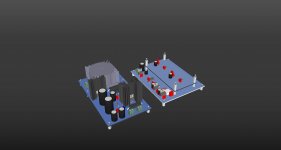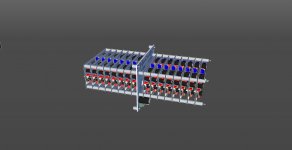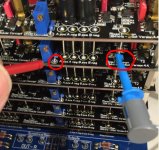I'm tempted to mix in my 4 old dac boards with the 4 new one with Tents. But I'm not so sure this is a good thing to do. I think a shootout between the old 4 deck vs. the new 4 deck with Tents is the way to go. I suspect the old boards will take away some of the advantage of using the Tent boards. Someone else with the old boards who share the same thoughts ?
Almeg69@
It's one hell of a monster dac you have put together, RESPECT !!!
Almeg69@
It's one hell of a monster dac you have put together, RESPECT !!!
I'm tempted to mix in my 4 old dac boards with the 4 new one with Tents. But I'm not so sure this is a good thing to do. I think a shootout between the old 4 deck vs. the new 4 deck with Tents is the way to go. I suspect the old boards will take away some of the advantage of using the Tent boards. Someone else with the old boards who share the same thoughts ?
Almeg69@
It's one hell of a monster dac you have put together, RESPECT !!!
I would not be afraid of mixing the Dac boards, it would lower the output impedance to drive the Sowter transformers and give more powerful bass with more refined vocals
No Sowters or Caps on the output in my dac. Balanced out, xlr.
Hi Smooth Dancer,
If you use balanced out (XLR), you'll still need 4 caps. Or am I wrong?
Please explain.
bye, Hans
Hi Hans
No, no caps at all. Connected "positive out" to pin 2 and "negative out" to pin 3 on xlr out from dac to my balanced Hegel P30 pre amp. Measure almost no dc at all at output from dac (0.004mv dc). "Common" is not in use when you go balanced, only "pos" and "neg".
I have tried the Cinemags and caps in my setup, and it's best without any of them. Resolution, dynamics and bass definition is better.
If you want to try without transformers or caps, make sure your amp can handle it.
No, no caps at all. Connected "positive out" to pin 2 and "negative out" to pin 3 on xlr out from dac to my balanced Hegel P30 pre amp. Measure almost no dc at all at output from dac (0.004mv dc). "Common" is not in use when you go balanced, only "pos" and "neg".
I have tried the Cinemags and caps in my setup, and it's best without any of them. Resolution, dynamics and bass definition is better.
If you want to try without transformers or caps, make sure your amp can handle it.
Hi Hans
No, no caps at all. Connected "positive out" to pin 2 and "negative out" to pin 3 on xlr out from dac to my balanced Hegel P30 pre amp. Measure almost no dc at all at output from dac (0.004mv dc). "Common" is not in use when you go balanced, only "pos" and "neg".
Don't get it : I measure 2,8 Vdc output, on 'pos' and 'neg' related to 'Ground'. It's not relevant to measure the voltage between 'pos' and 'neg' out.
I Think you have to be very careful with this 'direct' setup; you can easily ruin your preamp.
I'm tempted to mix in my 4 old dac boards with the 4 new one with Tents. But I'm not so sure this is a good thing to do. I think a shootout between the old 4 deck vs. the new 4 deck with Tents is the way to go. I suspect the old boards will take away some of the advantage of using the Tent boards. Someone else with the old boards who share the same thoughts ?
Almeg69@
It's one hell of a monster dac you have put together, RESPECT !!!
hi smooth dancer,
i am interested in this question too. i have 3 new decks installed (sounds already amazing
another question: is it okay to use longer (ca. 20 cm) connections between the new and the old decks or is this a problem for the signals?
mario
Hans !
Here is what Doede say.
hi Tuyen, nice work so far !
yes you need capacitors if there is a connection between both systems ground. this is normally the case, one way or the other. if not you can try without, as long as the amp can handle a few mV DC. that is what you will measure, please check, between POS and NEG terminal....
Here is what Doede say.
hi Tuyen, nice work so far !
yes you need capacitors if there is a connection between both systems ground. this is normally the case, one way or the other. if not you can try without, as long as the amp can handle a few mV DC. that is what you will measure, please check, between POS and NEG terminal....
Last edited:
Mario @
I have decided to use only the new boards with Tents. My old boards have been playing for a long time and I am familiar with the sound. My friend, which have the new boards, are also familiar with the sound from my "old" dac.
After he finished his dac and had been playing for a few days, he phone me and was very entusiastic about the sound. According to him this new dac is a step, or two, up the ladder.
We have almost identical amps and the same speakers.
I have decided to use only the new boards with Tents. My old boards have been playing for a long time and I am familiar with the sound. My friend, which have the new boards, are also familiar with the sound from my "old" dac.
After he finished his dac and had been playing for a few days, he phone me and was very entusiastic about the sound. According to him this new dac is a step, or two, up the ladder.
We have almost identical amps and the same speakers.
Last edited:
hi Tuyen, nice work so far !
yes you need capacitors if there is a connection between both systems ground. this is normally the case, one way or the other. if not you can try without, as long as the amp can handle a few mV DC. that is what you will measure, please check, between POS and NEG terminal....
Interesting! New insight.
Thanks, Hans.
There are quite a few people who ignore the common gnd on the outputs and only use pos and neg on each side as there is usually only a small dc offset of a few millivolts. You also get the benefit of an output that is twice the signal compared to Gnd to pos.Interesting! New insight.
Thanks, Hans.
There are quite a few people who ignore the common gnd on the outputs and only use pos and neg on each side as there is usually only a small dc offset of a few millivolts. You also get the benefit of an output that is twice the signal compared to Gnd to pos.
Let's not forget to mention, that you also have double the number of DACs by doing this. And the d2 harmonic is almost gone thanks to the balanced output.
I use the POS and NEG output through My own Sowters in TVC version. Without just doesn't work as the input of my pre amp is single ended. This would lead to the two NEG outputs of left and right channel to be connected together....
If you would have a complete floating double mono setup after the DAC the POS NEG output without capacitors or transformers is an excelent option !
Oh wow. I've been meaning to get this working for a long time and finally found some spare time.


Ignore the messy wires, this is just to get it working. So this is with the mainboard shift register disabled and the BBB set to output the right-justified data which is split into separate left and right data channels and then reclocked and patched into where the 3 resistors for each channel lrck, data, bck join in.
I currently have a weird volume thing going on, and this all needs tidying and doing properly but even so this is definitely the best I've heard my dddac and I though it was already quite good the clarity has taken another step forward.
the clarity has taken another step forward.
I'll post up more info when I have it more together, but essentially the how 2 is all here
http://www.diyaudio.com/forums/digi...pcm1794-waveio-usb-input-471.html#post4361633

James


Ignore the messy wires, this is just to get it working. So this is with the mainboard shift register disabled and the BBB set to output the right-justified data which is split into separate left and right data channels and then reclocked and patched into where the 3 resistors for each channel lrck, data, bck join in.
I currently have a weird volume thing going on, and this all needs tidying and doing properly but even so this is definitely the best I've heard my dddac and I though it was already quite good
I'll post up more info when I have it more together, but essentially the how 2 is all here
http://www.diyaudio.com/forums/digi...pcm1794-waveio-usb-input-471.html#post4361633
James
Last edited:
Hi James,
Have you had it's working without that irritating noise(s)?
The different between mine and your are: I bypassed the resistors on Cronus, and have them connected to the three input resistors at DAC. Which is the opposite to yours.
Please keep us posted. I too keen to get back to my DDDAC, it has been a while since my last attempt! DDDAC is sadly sitting there unloved!
Currently enjoying my Accuphase DC-37 via my All in One server build based on an Intel Atom build with Snakeoil OS. http://www.snakeoil-os.net
Cheers,
Chanh.

Sent from my iPhone using Tapatalk
Have you had it's working without that irritating noise(s)?
The different between mine and your are: I bypassed the resistors on Cronus, and have them connected to the three input resistors at DAC. Which is the opposite to yours.
Please keep us posted. I too keen to get back to my DDDAC, it has been a while since my last attempt! DDDAC is sadly sitting there unloved!
Currently enjoying my Accuphase DC-37 via my All in One server build based on an Intel Atom build with Snakeoil OS. http://www.snakeoil-os.net
Cheers,
Chanh.

Sent from my iPhone using Tapatalk
My noise and interference issues are gone totally if I lower the volume within the audio application (in this case Squeezelite) massively. For some reason the volume level within the digital signal has been boosted between 8 and 10 times normal, so anything over about 12% volume gets clipping and creates distortion. I'm sure it's a software setting and I need to dig a little further into the ALSA settings, but for now I'm happy that it's working and sounding great with the volumes set low.Hi James,
Have you had it's working without that irritating noise(s)?
The different between mine and your are: I bypassed the resistors on Cronus, and have them connected to the three input resistors at DAC. Which is the opposite to yours.
Please keep us posted. I too keen to get back to my DDDAC, it has been a while since my last attempt! DDDAC is sadly sitting there unloved!
Currently enjoying my Accuphase DC-37 via my All in One server build based on an Intel Atom build with Snakeoil OS. Snakeoil OS - Linux OS For The Audiophile
Cheers,
Chanh.

Sent from my iPhone using Tapatalk
Are there any components on the rear side of the main pcb? Or could the stack be on either side or even both?
I think someone tried on either side but it did not work. I2S lines are quite fussy about length and connection.
16 stacks seem to be the limit which I have a working example, but my dual stack dac tops out at 15 dac boards no matter what I tried ....
I just want to point out something important when building multiple decks...
If you are adjusting the bias to 40mV: One measuring point is the solder pad at the 100 Ohm resistor at the edge of the PCB. The other one is the common. But which one is the best to use?
For a single deck you can use the common from the analog output. However with multiple decks, the total bias current flowing over the mainboard tracks causes a small drop of some mV DC. No problem for the normal functionality, but it can just mess up your bias adjustment...
So best is to use for the common the actual common at the PCB. You can just clip the test pen on the wire connecting the decks. That will do …
I will have to update the building manuals…
If you are adjusting the bias to 40mV: One measuring point is the solder pad at the 100 Ohm resistor at the edge of the PCB. The other one is the common. But which one is the best to use?
For a single deck you can use the common from the analog output. However with multiple decks, the total bias current flowing over the mainboard tracks causes a small drop of some mV DC. No problem for the normal functionality, but it can just mess up your bias adjustment...
So best is to use for the common the actual common at the PCB. You can just clip the test pen on the wire connecting the decks. That will do …
I will have to update the building manuals…
Attachments
- Home
- Source & Line
- Digital Line Level
- A NOS 192/24 DAC with the PCM1794 (and WaveIO USB input)


